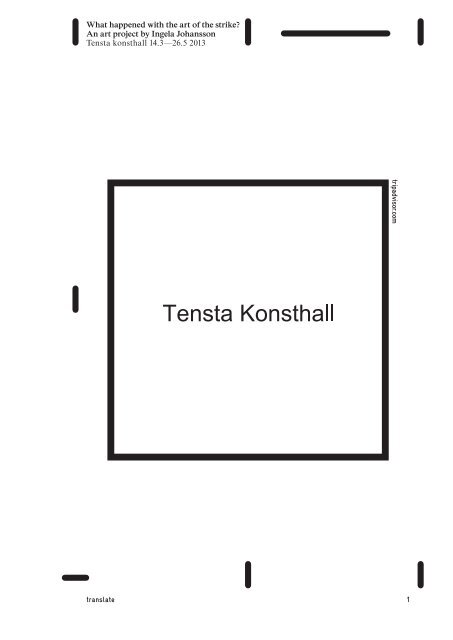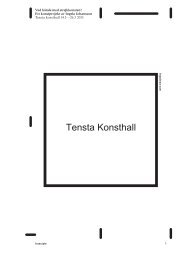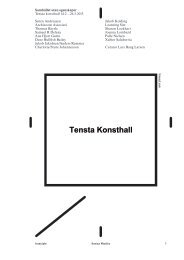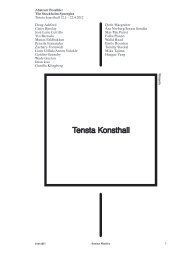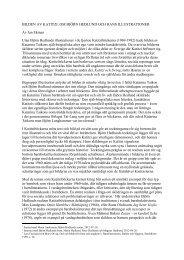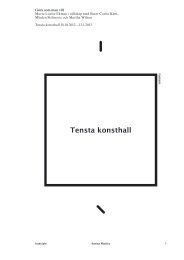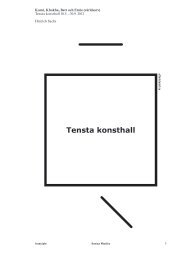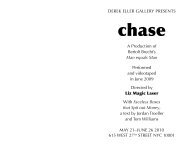What happened with the art of the strike? An art ... - Tensta konsthall
What happened with the art of the strike? An art ... - Tensta konsthall
What happened with the art of the strike? An art ... - Tensta konsthall
You also want an ePaper? Increase the reach of your titles
YUMPU automatically turns print PDFs into web optimized ePapers that Google loves.
<strong>What</strong> <strong>happened</strong> <strong>with</strong> <strong>the</strong> <strong>art</strong> <strong>of</strong> <strong>the</strong> <strong>strike</strong>?<br />
<strong>An</strong> <strong>art</strong> project by Ingela Johansson<br />
<strong>Tensta</strong> <strong>konsthall</strong> 14.3—26.5 2013<br />
translate<br />
tripadvisor.com<br />
1
In December 1969, a wildcat <strong>strike</strong> broke<br />
out in <strong>the</strong> iron ore fields in Norrbotten,<br />
<strong>the</strong> far north <strong>of</strong> Sweden. Despite <strong>the</strong> fact<br />
that it was a record year for Sweden and<br />
that <strong>the</strong> state-owned mining company<br />
LKAB made a pr<strong>of</strong>it, <strong>the</strong> working<br />
conditions <strong>of</strong> <strong>the</strong> miners became worse.<br />
The <strong>strike</strong> spread from Kiruna to<br />
Svappavaara and Malmberget and after<br />
a few days, involved some 5,000 miners.<br />
Through NLF (National Liberation<br />
Front/Vietnam) and o<strong>the</strong>r local political<br />
groups, many people working in culture<br />
expressed solidarity <strong>with</strong> <strong>the</strong> miners and<br />
engaged <strong>the</strong>mselves in <strong>the</strong>ir situation.<br />
Artist Ingela Johansson’s project <strong>What</strong><br />
<strong>happened</strong> <strong>with</strong> <strong>the</strong> <strong>art</strong> <strong>of</strong> <strong>the</strong> <strong>strike</strong>? is<br />
about <strong>the</strong> wildcat <strong>strike</strong>–which can be<br />
seen as one <strong>of</strong> <strong>the</strong> first major cracks in<br />
<strong>the</strong> facade <strong>of</strong> <strong>the</strong> welfare state–and <strong>the</strong><br />
effects it had on <strong>the</strong> cultural life. The<br />
project encompasses various investigations<br />
<strong>of</strong> <strong>the</strong> <strong>strike</strong>, and <strong>the</strong>se are materialized in<br />
different ways. One is an exhibition <strong>of</strong> <strong>the</strong><br />
Gruvarbetarnas strejkkonstsamling (The<br />
Miners’ Strike Art Collection), <strong>the</strong> largest<br />
p<strong>art</strong> <strong>of</strong> which is shown at <strong>Tensta</strong> <strong>konsthall</strong>.<br />
The collection consists <strong>of</strong> some one<br />
hundred <strong>art</strong>works which were donated by<br />
<strong>art</strong>ists in support <strong>of</strong> <strong>the</strong> <strong>strike</strong> fund.<br />
Among <strong>the</strong> <strong>art</strong>ists who donated work were<br />
Albin Amelin, Siri Derkert, Lars Hillersberg,<br />
and Berta Hansson. At present, <strong>the</strong><br />
collection is under <strong>the</strong> auspices <strong>of</strong> <strong>the</strong><br />
municipal Gällivare Museum.<br />
Ingela Johansson’s project also contains<br />
edited archive material, a series <strong>of</strong><br />
photographs and dramatizations based<br />
on <strong>strike</strong> documents.<br />
Various social and political groups were<br />
active all over Sweden to collect money for<br />
<strong>the</strong> miners' <strong>strike</strong> fund when <strong>the</strong>y did not<br />
get <strong>strike</strong> support from LO (The Swedish<br />
Trade Union Confederation). Several<br />
initiatives were taken on by <strong>the</strong> <strong>art</strong>s and<br />
culture scene to organize <strong>art</strong> auctions and<br />
fundraisers for <strong>the</strong> <strong>strike</strong>rs including by<br />
Sundsvall Museum, Stockholm Concert<br />
Hall, Moderna Muséet and Gallery<br />
Heland. The <strong>art</strong> works which were<br />
shipped to Malmfälten were never<strong>the</strong>less<br />
not sold. Instead, after <strong>the</strong> <strong>strike</strong>, <strong>the</strong>y<br />
were spread out and stored on different<br />
premises such as ABF (Workers’<br />
Educational Association), Gruv 4:an (4th<br />
Mine), and Folkets Hus in Malmberget.<br />
Over <strong>the</strong> years, <strong>the</strong> collection has been<br />
managed by <strong>the</strong> <strong>strike</strong> committee members<br />
and <strong>the</strong> local mining union, Gruv 4:an,<br />
in Malmberget, but since 2009 it has<br />
been stored at Gällivare Museum. The <strong>the</strong>atre groups such as <strong>the</strong> NJA group and<br />
collection is owned by <strong>the</strong> miners at LKAB. Teater Narren. P<strong>art</strong> <strong>of</strong> <strong>the</strong> project <strong>What</strong><br />
<strong>An</strong>o<strong>the</strong>r p<strong>art</strong> <strong>of</strong> Ingela Johansson’s<br />
<strong>happened</strong> <strong>with</strong> <strong>the</strong> <strong>art</strong> <strong>of</strong> <strong>the</strong> <strong>strike</strong>?<br />
project is a book which has been produced has been produced <strong>with</strong>in <strong>the</strong> framework<br />
at Konsthall C in collaboration <strong>with</strong> <strong>the</strong> <strong>of</strong> Kirunatopia, a residency programme<br />
poet and designer M<strong>art</strong>in Högström, and initiated by <strong>the</strong> Goe<strong>the</strong> Institute, Sweden<br />
will be printed during <strong>the</strong> spring <strong>of</strong> 2013. and Konsthall C in cooperation <strong>with</strong> <strong>the</strong><br />
The book focuses on how <strong>the</strong> miners’ municipality <strong>of</strong> Kiruna and <strong>the</strong> Art College<br />
<strong>strike</strong> brought toge<strong>the</strong>r <strong>the</strong> 1968<br />
at Umeå University, <strong>the</strong> Bildmuseet and<br />
movement, popular movements, and <strong>the</strong> Gällivare Museum. The project has<br />
working-class Left. The <strong>strike</strong> is depicted been subsidized by <strong>the</strong> Swedish Arts<br />
through a montage <strong>of</strong> documentary<br />
Grants Committee. Thanks to <strong>the</strong> Swedish<br />
materials, play manuscripts, texts, and<br />
contemporary interviews. <strong>An</strong> important<br />
Royal Dramatic Theater.<br />
point <strong>of</strong> dep<strong>art</strong>ure for <strong>the</strong> book is <strong>the</strong> In <strong>the</strong> exhibition:<br />
cultural productions that were created in Art Collection: The Mineworkers’ Art<br />
conjunction <strong>with</strong> <strong>the</strong> <strong>strike</strong>. The cultural Collection from <strong>the</strong> <strong>strike</strong> in 1969,<br />
workers' engagement in social and<br />
Gällivare Museum<br />
political movements and democratization For <strong>the</strong> complete list <strong>of</strong> works in <strong>the</strong><br />
processes during 1968 has been added to collection please refer to <strong>the</strong> end<br />
<strong>the</strong> history <strong>of</strong> <strong>the</strong> <strong>strike</strong>. In addition to<br />
The Miners’ Strike Art Collection, <strong>the</strong>se<br />
<strong>of</strong> <strong>the</strong> hand out<br />
include Sara Lidman’s and Odd Uhrbom’s Documents:<br />
reportage book, Gruva (The Mine), <strong>the</strong> - Poster I, Telegram to <strong>the</strong> <strong>strike</strong><br />
documentary film Kamrater, motståndare committee from <strong>the</strong> Swedish people<br />
är välorganiserad (Comrades, <strong>the</strong><br />
- Poster II, Inventory list by Östen<br />
Opposition Is Well Organized), which will Öhlund, member <strong>of</strong> <strong>the</strong> <strong>strike</strong> committee<br />
be screened on 20.03 at <strong>Tensta</strong> <strong>konsthall</strong>, Video: Speech to <strong>the</strong> mineworkers by Sara<br />
Gruvstrejken 69/70 (The Mine Strike Lidman, staged by Cecilia Nilsson on<br />
69/70) by Margareta Vinterheden and 13.3. 2013 at <strong>Tensta</strong> <strong>konsthall</strong>. Concept by<br />
Alf Israelsson, and performances <strong>of</strong><br />
Ingela Johansson. In <strong>the</strong> café.<br />
2 <strong>What</strong> <strong>happened</strong> <strong>with</strong> <strong>the</strong> <strong>art</strong> <strong>of</strong> <strong>the</strong> <strong>strike</strong>?
Interview <strong>with</strong> Ingela Johansson<br />
conducted by curator Kim Einarsson<br />
on 10.4.2012<br />
Kim Einarsson: Many <strong>of</strong> your works<br />
show your interest in how <strong>art</strong> is collected<br />
and mediated, and <strong>the</strong> ideologies involved.<br />
In this project you have chosen to show<br />
<strong>the</strong> <strong>art</strong> collection that was established in<br />
connection <strong>with</strong> <strong>the</strong> big mining <strong>strike</strong> at<br />
Svappavaara, Malmberget, and Kiruna<br />
in 1969-1970. <strong>What</strong> specifically about this<br />
<strong>strike</strong> and collection interested you?<br />
Ingela Johansson: The <strong>strike</strong> brought<br />
to <strong>the</strong> fore <strong>the</strong> power relationships in<br />
working life and <strong>the</strong> forces behind<br />
society’s development. One wanted to<br />
have increased influence over work and<br />
<strong>the</strong> organisation <strong>of</strong> work. The critique<br />
<strong>of</strong> ideology was a strong current in <strong>the</strong><br />
intellectual world and <strong>the</strong> city political<br />
machine’s influence over cultural practice<br />
was a complicated one. There was a<br />
massive support fund raised for <strong>the</strong><br />
<strong>strike</strong>rs among cultural practitioners<br />
around <strong>the</strong> country. I find <strong>the</strong> act <strong>of</strong><br />
donating <strong>art</strong> in solidarity <strong>with</strong> <strong>the</strong> <strong>strike</strong>rs<br />
very interesting: to give away something as<br />
a gift <strong>with</strong> <strong>the</strong> idea that <strong>the</strong> striking miners<br />
and can contribute by showing <strong>the</strong><br />
collection in an <strong>art</strong> context, and convey a<br />
symbolic image <strong>of</strong> <strong>the</strong> <strong>strike</strong> in dialogue<br />
<strong>with</strong> o<strong>the</strong>r collections. <strong>What</strong> is especially<br />
interesting <strong>with</strong> <strong>the</strong> miner <strong>strike</strong>’s <strong>art</strong><br />
collection is that this historical<br />
representation is broad--that it has roots<br />
in <strong>the</strong> people and worker’s movement, but<br />
also in an <strong>art</strong> scene <strong>with</strong> many prominent<br />
modernists represented. It is an important<br />
document <strong>of</strong> its time.<br />
KE: Your project builds on several years<br />
<strong>of</strong> work on this <strong>strike</strong> and <strong>the</strong> cultural<br />
productions that arose as acts <strong>of</strong> solidarity<br />
<strong>with</strong> <strong>the</strong> striking workers. You have a<br />
gigantic amount <strong>of</strong> archival material. Can<br />
you say something about your selection <strong>of</strong><br />
material for this presentation in Umeå?<br />
IJ: It is important to see <strong>the</strong> collection as a<br />
collection <strong>with</strong> its own body and its own<br />
fate. It represents <strong>the</strong> <strong>strike</strong> committee. I<br />
have seen <strong>the</strong> opportunity <strong>of</strong> collaborating<br />
<strong>with</strong> Gällivare Museum to research on <strong>the</strong><br />
collection for a larger ongoing text work<br />
as a parallel activity to actually presenting<br />
it physically to an audience in a museum.<br />
Considering <strong>the</strong> historical context <strong>of</strong> <strong>the</strong><br />
collection, that it belongs to <strong>the</strong> <strong>strike</strong><br />
translate<br />
had <strong>the</strong> potential to change society. The<br />
collection tells a history about <strong>the</strong> fact<br />
that <strong>art</strong>ists stood up for <strong>the</strong> miners in a<br />
labour market conflict that shook <strong>the</strong><br />
Swedish Model significantly. It is also a<br />
great resource as a document <strong>of</strong> its time<br />
that allows one to fur<strong>the</strong>r analyse larger<br />
structures, such as <strong>the</strong> power relationship<br />
between <strong>the</strong> individual and <strong>the</strong> state<br />
during a time <strong>of</strong> social flux, as <strong>the</strong> ‘60-70s<br />
is commonly characterised. Precisely this<br />
perspective felt relevant and important to<br />
address in relation to <strong>the</strong> <strong>art</strong>works that are<br />
represented in <strong>the</strong> collection, which has<br />
found a home at Gällivare Museum, a<br />
hundred kilometres south <strong>of</strong> Kiruna. The<br />
collection consists <strong>of</strong> sculptures, paintings,<br />
drawings, and graphic <strong>art</strong>: works that were<br />
donated by <strong>art</strong>ists to <strong>the</strong> miners to<br />
supplement <strong>the</strong>ir <strong>strike</strong> fund through<br />
various auctions and collections.<br />
In ano<strong>the</strong>r parallel work-in-progress I<br />
examine <strong>the</strong> zeitgeist <strong>of</strong> <strong>the</strong> ‘60s and ‘70s<br />
and o<strong>the</strong>r cultural productions that were<br />
connected to <strong>the</strong> <strong>strike</strong>, which was a p<strong>art</strong><br />
<strong>of</strong> a larger widespread current <strong>of</strong> activism<br />
that occurred around <strong>the</strong> <strong>strike</strong>. On <strong>the</strong><br />
whole, this is an almost impossible task<br />
because I was not involved myself during<br />
this period, but I’ve studied it a great deal<br />
committee, I have st<strong>art</strong>ed from <strong>the</strong><br />
minutes <strong>of</strong> <strong>the</strong> committee meetings where<br />
<strong>the</strong> collection is mentioned. The collection<br />
was not sold after <strong>the</strong> <strong>strike</strong>, but <strong>the</strong><br />
committee did wonder what <strong>the</strong>y should<br />
do <strong>with</strong> it. They wanted to initiate a<br />
travelling exhibition, under <strong>the</strong> responsibility<br />
<strong>of</strong> <strong>the</strong> Malmberget librarian Adolf<br />
Henriksson, in which <strong>the</strong> <strong>art</strong> would be<br />
shown toge<strong>the</strong>r <strong>with</strong> o<strong>the</strong>r documents<br />
from <strong>the</strong> collection, but this never <strong>happened</strong><br />
for some unknown reason. I wanted to<br />
pursue <strong>the</strong> idea, but have made a<br />
compromise before <strong>the</strong> exhibition at<br />
Bildmuseet. Gällivare Museum has gotten<br />
<strong>the</strong> work in <strong>the</strong> best condition possible<br />
since <strong>the</strong> collection is not complete. It is<br />
important to not make a selection, but to<br />
initially follow <strong>the</strong> inventory list from <strong>the</strong><br />
committee and <strong>the</strong> <strong>strike</strong> committee’s<br />
protocol as much as possible. The<br />
collection has not been shown outside <strong>of</strong><br />
Norrbotten before. Bildmuseet is today<br />
<strong>the</strong> largest <strong>art</strong> museum in nor<strong>the</strong>rn Sweden<br />
and <strong>the</strong> opportunity was given to<br />
showcase <strong>the</strong> majority <strong>of</strong> <strong>the</strong> collection<br />
under <strong>the</strong> umbrella <strong>of</strong> Kirunatopia.<br />
KE: For <strong>the</strong> opening you have arranged a<br />
staging <strong>of</strong> <strong>the</strong> speech that <strong>the</strong> author Sara<br />
3
Lidman gave to <strong>the</strong> miners during <strong>the</strong><br />
<strong>strike</strong>. Can you say something briefly<br />
about how <strong>the</strong> speech is connected to <strong>the</strong><br />
<strong>strike</strong> collection?<br />
IJ: Sara Lidman was a key figure during<br />
<strong>the</strong> <strong>strike</strong>. She came to Kiruna as a<br />
reporter for TV 2 and gave an impromptu<br />
speech at <strong>the</strong> general meeting in Kiruna<br />
Gymnasium on 12 November 1969. Sara<br />
was well acquainted <strong>with</strong> <strong>the</strong> plight <strong>of</strong> <strong>the</strong><br />
miners. In 1968 she wrote <strong>the</strong> texts for a<br />
book called Gruva (Mine), about <strong>the</strong><br />
inhumane working conditions in <strong>the</strong><br />
LKAB mine, accompanied by Odd<br />
Uhrbom’s photography. It was an exposé––<br />
portraits in words and images, anonymous<br />
stories <strong>of</strong> <strong>the</strong> abuses at <strong>the</strong> state-owned<br />
enterprise––and a book that would come<br />
to play a major role in <strong>the</strong> <strong>strike</strong>’s<br />
development and in defining <strong>the</strong> dispute.<br />
For example, it came out that <strong>the</strong> finance<br />
minister Gunnar Sträng disliked <strong>the</strong><br />
book’s influence and sought to discredit it.<br />
At <strong>the</strong> <strong>strike</strong> meeting in Kiruna<br />
Gymnasium, Sara decided to donate<br />
10,000 SEK <strong>of</strong> <strong>the</strong> honorarium she<br />
received for <strong>the</strong> second edition <strong>of</strong> Gruva<br />
to form <strong>the</strong> nucleus <strong>of</strong> a <strong>strike</strong> fund.<br />
It was a telling gesture that encouraged<br />
Wednesday 20.3<br />
18:30<br />
Screening <strong>of</strong> <strong>the</strong> film Kamrater<br />
motståndaren är välorganiserad by<br />
Lars Westman and Lena Ewert <strong>with</strong> an<br />
introduction by Ingela Johansson. Talk<br />
about <strong>the</strong> representation <strong>of</strong> <strong>the</strong> <strong>strike</strong><br />
between Ingela Johansson and Robert<br />
Nilsson, Phd student in History at<br />
Historiska institutionen, Stockholms<br />
universitet. Moderator: Giorgiana<br />
Zachia, producer, <strong>Tensta</strong> <strong>konsthall</strong>.<br />
Saturday 6.4<br />
14:00<br />
Ingela Johansson presents <strong>the</strong> exhibition<br />
at <strong>Tensta</strong> <strong>konsthall</strong>.<br />
Wednesday 17.4<br />
18.00<br />
Witness seminar: <strong>What</strong> was <strong>the</strong> meaning<br />
<strong>of</strong> <strong>the</strong> medium <strong>of</strong> <strong>the</strong> exhibition in<br />
relation to <strong>the</strong> 1968-movement? <strong>with</strong><br />
Louise Waldén, Carl Henrik Svenstedt,<br />
Helena Friman, Eva Persson and Sköld<br />
Peter Matthis. Moderators: Kjell Östberg<br />
and Maria Lind, director <strong>of</strong> <strong>Tensta</strong><br />
<strong>konsthall</strong>. In collaboration <strong>with</strong> The<br />
Institute <strong>of</strong> Contemporary History at<br />
Södertörn University.<br />
4<br />
o<strong>the</strong>r cultural workers to follow suit. The<br />
staging <strong>of</strong> Sara Lidman’s speech <strong>the</strong>refore<br />
gives <strong>the</strong> collection a background context<br />
in <strong>the</strong> nationwide fundraising effort and<br />
explains directly how <strong>the</strong> <strong>strike</strong> fund came<br />
into being. Sara also had a strong<br />
rhetorical voice that influenced public<br />
opinion and she spoke passionately at<br />
demonstrations to get people to support<br />
<strong>the</strong> <strong>strike</strong>rs. Sara was also very good<br />
friends <strong>with</strong> Berta Hansson and Siri Derkert,<br />
two <strong>of</strong> <strong>the</strong> <strong>art</strong>ists represented in <strong>the</strong><br />
collection. Berta directly initiated an <strong>art</strong><br />
auction at Galleri Heland in Stockholm.<br />
<strong>What</strong>’s on at <strong>Tensta</strong> <strong>konsthall</strong> during<br />
<strong>What</strong> <strong>happened</strong> <strong>with</strong> <strong>the</strong> <strong>art</strong> <strong>of</strong> <strong>the</strong><br />
<strong>strike</strong>? in collaboration <strong>with</strong> ABF<br />
Every Thursday and Saturday 14:00,<br />
<strong>Tensta</strong> <strong>konsthall</strong>’s staff introduces <strong>the</strong><br />
exhibition<br />
Wednesday 13.3,<br />
17:00-20:00<br />
Opening <strong>with</strong> performance at 17:00 by<br />
Cecilia Nilsson, who stages Sara Lidman’s<br />
speech to <strong>the</strong> striking miners.<br />
Thursday 25.4<br />
13:00-17:00<br />
Seminar about representation and <strong>the</strong> gift<br />
<strong>of</strong> solidarity <strong>with</strong> Irina Sandomirskaja,<br />
Pr<strong>of</strong>essor <strong>of</strong> Cultural Studies at The<br />
Centre for Baltic and East European<br />
Studies; Ludger Hagedorn, Research<br />
Fellow at <strong>the</strong> Institut für die Wissenschaften<br />
vom Menschen; Leonard Neuger,<br />
Pr<strong>of</strong>essor <strong>of</strong> Polish at <strong>the</strong> University <strong>of</strong><br />
Stockholm; Tora Lane, Researcher in<br />
Slavic Studies at Södertörn University;<br />
Gustav Strandberg, Doctoral student in<br />
Philosophy at Södertörn University; and<br />
Marcia Sá Cavalcante Schuback, Pr<strong>of</strong>essor<br />
<strong>of</strong> Philosophy at Södertörn University.<br />
Solidarity: something that <strong>the</strong>re was so<br />
much <strong>of</strong> in <strong>the</strong> ’70s in Sweden, or <strong>the</strong> ’80s<br />
in Poland. But what <strong>happened</strong> to <strong>the</strong> word<br />
after that? Solidarity has many languages.<br />
It manifests itself in gestures, gifts, and<br />
encouragement. But how does it relate to<br />
power? Where does solidarity stem from?<br />
Who does it include (or exclude)? <strong>What</strong> is<br />
<strong>the</strong> value <strong>of</strong> a (symbolic) gift <strong>of</strong>fered in a<br />
gesture <strong>of</strong> solidarity <strong>of</strong>fer? One <strong>of</strong> <strong>the</strong><br />
most striking features <strong>of</strong> solidarity is <strong>the</strong><br />
possibility <strong>of</strong> giving a gift <strong>of</strong> language as<br />
such, finding means to express what was<br />
silenced, and to represent common<br />
<strong>What</strong> <strong>happened</strong> <strong>with</strong> <strong>the</strong> <strong>art</strong> <strong>of</strong> <strong>the</strong> <strong>strike</strong>?
experience. The Swedish <strong>art</strong>ists who<br />
supported <strong>the</strong> great <strong>strike</strong> <strong>of</strong> <strong>the</strong> miners in<br />
1969-1970 did so in an act <strong>of</strong> solidarity.<br />
But who gave <strong>the</strong> gift <strong>of</strong> language—<strong>the</strong><br />
miners or <strong>the</strong> <strong>art</strong>ists?<br />
Wednesday 15.5<br />
18.30<br />
Talk about Filialen between Pär Stolpe<br />
and Maria Lind.<br />
In 1969, Pär Stolpe was hired by Pontus<br />
Hultén to make Moderna Museets<br />
exhibitions and museum programs more<br />
radical. This resulted in <strong>the</strong> experimental<br />
project Filialen (The Branch) (1971-<br />
1973). Filialen was a public education<br />
project <strong>with</strong> focus on counter cultures,<br />
protest actions, and on <strong>the</strong> third world,<br />
<strong>with</strong> <strong>the</strong> aim <strong>of</strong> looking at <strong>the</strong> social and<br />
political movements following 1968 to<br />
broaden <strong>the</strong> notion <strong>of</strong> <strong>the</strong> image. Filialen<br />
got its own dep<strong>art</strong>ment in one <strong>of</strong> <strong>the</strong><br />
barrack buildings on Skeppsholmen i<br />
Stockholm. As a curator, Stolpe set out to<br />
reach an audience not familiar <strong>with</strong> <strong>art</strong> to<br />
visit <strong>the</strong> museum. He wanted to<br />
incorporate <strong>the</strong> processes <strong>of</strong> democracy<br />
into <strong>the</strong> exhibition space to evoke<br />
questions around <strong>the</strong> freedom <strong>of</strong> speech.<br />
Some <strong>of</strong> <strong>the</strong> exhibitions were Mitt hem är<br />
portraits <strong>of</strong> <strong>the</strong> miners and <strong>the</strong>ir relatives.<br />
Central in <strong>the</strong> film are <strong>the</strong> mass ga<strong>the</strong>rings<br />
and <strong>the</strong> unity <strong>of</strong> <strong>the</strong> miners.<br />
Self-presentations<br />
Marcia Sá Cavalcante Schuback is a<br />
pr<strong>of</strong>essor <strong>of</strong> philosophy at Södertörn<br />
University (Sweden). She has also worked<br />
as associate pr<strong>of</strong>essor at <strong>the</strong> Universidade<br />
Federal do Rio de Janeiro (UFRJ) in<br />
Brazil. Her field <strong>of</strong> research is continental<br />
philosophy, <strong>with</strong> focus on phenomenology,<br />
hermeneutics, German Idealism, and<br />
hermeneutical readings <strong>of</strong> ancient<br />
philosophy. She is <strong>the</strong> author <strong>of</strong> O<br />
começo de deus: A filos<strong>of</strong>ia do devir no<br />
pensamento tardio de F. W. J. Schelling<br />
(Vozes, 1998), A doutrina dos sons de<br />
Goe<strong>the</strong> a caminho da música nova de<br />
Webern (UFRJ, 1999), Para ler os<br />
medievais: Ensaio de hermenêutica<br />
imaginativa (Vozes, 2000), Lovtal till<br />
intet: essäer om filos<strong>of</strong>isk hermeneutik<br />
(Glänta, 2006), Olho a olho: ensaios de<br />
longe (7 Letras, 2011), Att tänka i<br />
skisser (Glänta, 2011). She has also<br />
translated several works <strong>of</strong> philosophy<br />
into Portuguese, among o<strong>the</strong>rs Being in<br />
Time by M<strong>art</strong>in Heidegger.<br />
translate<br />
Palestina (My home is Palestine) <strong>with</strong><br />
Odd Uhrbom, Folkets och maktens<br />
murar (The People and <strong>the</strong> Walls <strong>of</strong> <strong>the</strong><br />
Power) <strong>with</strong> Gun Kessle and Jan Myrdal,<br />
and Kvinnor (Women) <strong>with</strong> Grupp 8.<br />
During Stolpe’s time as a curator at<br />
Moderna Museet, “evenings <strong>of</strong> solidarity”<br />
and fundraisers brought toge<strong>the</strong>r popular<br />
<strong>art</strong>ists, activists, and political groups to<br />
support groups like <strong>the</strong> striking miners<br />
during <strong>the</strong> Miners’ Strike from 1969 to<br />
1970, and The Black Pan<strong>the</strong>rs.<br />
Friday 17.5<br />
15:00<br />
The Great Mine Strike <strong>of</strong> Sweden<br />
(1970) av Margareta Vinterheden och Alf<br />
Israelsson. 73 min.<br />
"If you can go to <strong>the</strong> moon you should be<br />
able to have a 100 percent emission…"<br />
says <strong>the</strong> miner Björn Holmberg when he<br />
describes <strong>the</strong> background <strong>of</strong> <strong>the</strong> <strong>strike</strong>.<br />
One <strong>of</strong> <strong>the</strong> reasons for it was <strong>the</strong><br />
dangerous work environment <strong>with</strong> <strong>the</strong><br />
hazardous diesel gases in <strong>the</strong> mine. The<br />
documentary follows <strong>the</strong> <strong>strike</strong> in<br />
Malmfälten toge<strong>the</strong>r <strong>with</strong> material from<br />
<strong>the</strong> general assemblies, demonstrations<br />
and union meetings as well as personal<br />
Helena Friman. In <strong>the</strong> late 1960s, when<br />
I took <strong>the</strong> step into <strong>the</strong> world <strong>of</strong> <strong>the</strong><br />
museum, it was a time <strong>of</strong> confrontations<br />
when <strong>the</strong> role <strong>of</strong> <strong>the</strong> museums changed<br />
rapidly, and many <strong>of</strong> <strong>the</strong>m transformed<br />
into stages for social critique and debate.<br />
At <strong>the</strong> Stockholm City Museum where I<br />
worked until 1992, we made exhibitions<br />
that criticized <strong>the</strong> city planning and <strong>the</strong><br />
capitalist society’s waste <strong>of</strong> resources.<br />
Some <strong>of</strong> <strong>the</strong> exhibitions were Spanien<br />
(Spain) 1936, Än sen då (So <strong>What</strong>),<br />
Staden i retur (The recycled city) and Du<br />
gamla du fria (Thou ancient, Thou free).<br />
One exhibition informed viewers about <strong>the</strong><br />
Black Pan<strong>the</strong>rs’ work <strong>with</strong> children and<br />
schools in USA’s big cities. In 1993 The<br />
EU decided that Stockholm was going to<br />
be <strong>the</strong> European Capital <strong>of</strong> Culture in<br />
1998. I gave <strong>the</strong> committee <strong>of</strong> <strong>the</strong> Capital<br />
<strong>of</strong> Culture a suggestion about a special<br />
“Stockholm education” for <strong>the</strong> people<br />
who worked <strong>with</strong> <strong>the</strong> infrastructure in <strong>the</strong><br />
city. These would be custom-made classes<br />
that would take place out on <strong>the</strong> streets <strong>of</strong><br />
<strong>the</strong> city <strong>with</strong> <strong>the</strong> city itself as an<br />
instrument and learning tool. The<br />
committee took on <strong>the</strong> suggestion and<br />
from fall 1996 until New Years Eve in<br />
1998, I Stockholm-educated thousands <strong>of</strong><br />
5
police <strong>of</strong>ficers, parking attendants, bus<br />
drivers, subway employees, guards, cabinet<br />
guards, librarians, social workers, and hot<br />
dog vendors. From 1998 until 2006 I<br />
continued <strong>the</strong> Stockholm Education under<br />
my own private firm. For <strong>the</strong> last few<br />
years I have worked on different projects,<br />
lectured, and written books about<br />
Stockholm. Since 2012, I work toge<strong>the</strong>r<br />
<strong>with</strong> o<strong>the</strong>r activists most recently in<br />
connection <strong>with</strong> <strong>the</strong> big exhibition about<br />
Slussen, När Stockholm var modernt<br />
(When Stockholm was modern) at The<br />
Royal Swedish Academy <strong>of</strong> Fine Arts. The<br />
exhibition was made because <strong>the</strong> city is<br />
going to choose a better plan for <strong>the</strong><br />
rebuilding <strong>of</strong> Slussen--a kind <strong>of</strong> subversive<br />
operation in <strong>the</strong> service <strong>of</strong> <strong>the</strong> society.<br />
Ludger Hagedorn is a Research Fellow<br />
at <strong>the</strong> Institute for Human Sciences<br />
(IWM) in Vienna. After studying<br />
Philosophy and Slavic Languages, he<br />
obtained his PhD from Technical<br />
University Berlin in 2002. From 2005 to<br />
2009 he was Purkyne-Fellow at <strong>the</strong> Czech<br />
Academy <strong>of</strong> Sciences. His main interests<br />
include phenomenology, political<br />
philosophy, modernity and secularization.<br />
As a lecturer, he has worked at <strong>the</strong><br />
collaborated <strong>with</strong> o<strong>the</strong>r <strong>art</strong>ists and<br />
experts, and has organized discussions. A<br />
selection <strong>of</strong> places in which Ingela<br />
Johansson has exhibited includes:<br />
Konsthall C, Stockholm (2012),<br />
Bildmuseet, Umeå (2012), Västerbottens<br />
museum, Umeå (2011), Gallery Box,<br />
Göteborg (2010); Periferic Biennale 8,<br />
Iasi, Romania (2008); <strong>What</strong> about power<br />
relations, Ex Poonto, SKUC Gallery,<br />
Ljubljana, Slovenia, 2008; and Exteriors,<br />
CCA Kiev, Ukrania (2007).<br />
Tora Lane is currently working as<br />
Associate Pr<strong>of</strong>essor in Philosophy at<br />
Södertörn University <strong>with</strong>in <strong>the</strong> project<br />
Loss <strong>of</strong> Grounds as Common<br />
Grounds. In 2009, she defended her <strong>the</strong>sis<br />
on <strong>the</strong> Russian poet Marina Tsvetaeva<br />
in Russian Literature at Stockholm<br />
University, and <strong>the</strong> <strong>the</strong>sis was awarded a<br />
special prize from <strong>the</strong> Swedish Academy.<br />
Main research interests are Modernism<br />
and <strong>the</strong> relation between Philosophy<br />
and Literature.<br />
Sköld Peter Matthis, born in 1937, is a<br />
Swedish medical doctor and a political<br />
activist. Matthis, who has been active in<br />
Cl<strong>art</strong>é since <strong>the</strong> 1950s, became famous as<br />
6<br />
Gutenberg-University Mainz, at<br />
Södertörns Högskola (Stockholm) and for<br />
several years at Charles University in<br />
Prague.<br />
Ingela Johansson has a social practice<br />
that is both research- and productionbased,<br />
responding to site-specific issues<br />
using diverse positions. Her work <strong>of</strong>ten<br />
st<strong>art</strong>s <strong>with</strong> archive research and continues<br />
into various presentations, extending <strong>the</strong><br />
document into different expressions,<br />
activating it and discussing its politics and<br />
language. Johansson is using an<br />
interdisciplinary approach; <strong>the</strong><br />
representation <strong>of</strong> politics mixes <strong>with</strong> ideas<br />
and methods from philosophy, poetry, and<br />
history. The media includes video,<br />
reenactment, photo, text, and installation.<br />
With her practice she challenges <strong>the</strong><br />
political, ethical, social, and institutional<br />
issues in order to discuss <strong>the</strong>m through<br />
ano<strong>the</strong>r perspective. She is interested in<br />
what is left out <strong>of</strong> <strong>the</strong> collective history<br />
and why, especially in regards to <strong>the</strong><br />
<strong>of</strong>ficial writing <strong>of</strong> history. Several <strong>of</strong> her<br />
works address <strong>the</strong> institution and <strong>the</strong><br />
museum as a place for <strong>the</strong> public, as<br />
public space, and as an organization. As<br />
p<strong>art</strong> <strong>of</strong> her practice, she has regularly<br />
”<strong>the</strong> first Vietnam protester” when he was<br />
arrested at Hötorget in Stockholm after<br />
standing <strong>the</strong>re <strong>with</strong> a placard saying<br />
”USA get out <strong>of</strong> Vietnam.” Even though<br />
he had a permit to demonstrate, he was<br />
arrested for disorderly conduct and<br />
resisting arrest. The arrest got a lot <strong>of</strong><br />
attention and helped <strong>the</strong> emerging<br />
Vietnam movement on its way. Matthis<br />
was <strong>the</strong>n involved in st<strong>art</strong>ing De förenade<br />
FNL-grupperna (DFFG) (The United<br />
NLF Groups), which grew to be one <strong>of</strong><br />
<strong>the</strong> west’s strongest NLF solidarity<br />
movements during <strong>the</strong> Vietnam war. In<br />
2003, Matthis was also involved in st<strong>art</strong>ing<br />
Nätverket mot krig (The Network<br />
against war), which arranged protests<br />
against <strong>the</strong> USA's invasion <strong>of</strong> Iraq. In<br />
2005, he was involved in <strong>the</strong> founding <strong>of</strong><br />
<strong>the</strong> organisation Iraksolidaritet (Iraq<br />
solidarity), which is exclusively occupied<br />
<strong>with</strong> <strong>the</strong> Iraq issue.<br />
. .<br />
Leonard Neuger (b. 1947 in Krakow)<br />
studied at <strong>the</strong> Jagiellonian univeristetet,<br />
and took his PhD at <strong>the</strong> Silesian University<br />
in Katowice. Since 1983, he has being living<br />
in Sweden after having received political<br />
asylum. In 2000, he became a pr<strong>of</strong>essor at<br />
Stockholm University. From 2004-2007,<br />
<strong>What</strong> <strong>happened</strong> <strong>with</strong> <strong>the</strong> <strong>art</strong> <strong>of</strong> <strong>the</strong> <strong>strike</strong>?
he was Head <strong>of</strong> <strong>the</strong> Dep<strong>art</strong>ment <strong>of</strong> Slavic<br />
Languages, and since 2011, he has been a<br />
pr<strong>of</strong>essor at Södertörn University and<br />
Honorary Pr<strong>of</strong>essor at <strong>the</strong> Silesian<br />
University. Alongside his research, he deals<br />
<strong>with</strong> translation <strong>of</strong> Swedish literature into<br />
Polish. (O <strong>of</strong> CM Bellman, EJStagnelius<br />
T. Tranströmer, K. Frostenson, H.<br />
M<strong>art</strong>inson, R. tower Borg, M. Florin.) He<br />
has published about 200 scientific texts and<br />
also published <strong>the</strong> following books:<br />
Pomysły do intepretacji. Studia in szkice<br />
o literaturze Polskiej (Cracow 1997),<br />
Z perspektywy tłumacza. Szkice o poezji<br />
szwedzkiej (Cracow 1997), Cwiczenia z<br />
wrazliwosci. Duze in Male szkice<br />
literackie (Katowice 2006), and translated<br />
Marcia Schuback's book Lovtal till intet.<br />
Essäer ni filos<strong>of</strong>isk hermenutik<br />
(Pochwała nicosci. Eseje z hermeneutyki<br />
filoz<strong>of</strong>icznej), Kraków 2008.<br />
Cecilia Nilsson in an actor educated at<br />
<strong>the</strong> Swedish National Academy <strong>of</strong> Mime<br />
and Acting (now called Stockholm<br />
Academy <strong>of</strong> Dramatic Arts) from 1978 to<br />
1981. She has worked <strong>with</strong> <strong>the</strong>atre, TV,<br />
film, etc. and since 1999 has been a p<strong>art</strong> <strong>of</strong><br />
TeaterAlliansen. In 2012 she acted in<br />
Den flygade handläggaren (The Flying<br />
historical event, and what templates have<br />
been created to express and think through<br />
personal memories.<br />
Eva Persson. To, as I did, come from <strong>the</strong><br />
world <strong>of</strong> <strong>the</strong> museum to being an<br />
exhibition producer at Riksutställningar<br />
was like coming to heaven. The year was<br />
1967 and Riksutställningar (The Swedish<br />
Travelling Exhibitions) had just st<strong>art</strong>ed<br />
<strong>the</strong>ir work as an ambulant space for<br />
exhibitions where all voices should be<br />
heard. I invited <strong>art</strong>ists, journalists, writers,<br />
musicians, photographers, and architects<br />
that I liked to be responsible for <strong>the</strong>ir own<br />
exhibitions. In 1989, I was asked to<br />
become <strong>the</strong> <strong>art</strong>istic director and exhibition<br />
producer at Arbetets Museum (Museum<br />
<strong>of</strong> Work) in Norrköping, and stayed <strong>the</strong>re<br />
until <strong>the</strong> freedom that I had gotten used to<br />
at Riksutställningar disappeared. In 1997,<br />
I became a teacher in <strong>the</strong> <strong>the</strong>ory and<br />
practice <strong>of</strong> exhibitions at a new program<br />
in Culture, Society and Media production<br />
at Linköping University-Norrköping<br />
Campus. During my final years <strong>the</strong>re, I<br />
st<strong>art</strong>ed a webpage about exhibition<br />
aes<strong>the</strong>tics (www.ueforum.se). Today it is<br />
run by a younger generation. In respect <strong>of</strong><br />
my age, today I only devote myself to<br />
translate<br />
Administrator) at Uppsala Stadsteater,<br />
and is currently acting in Den goda<br />
människan (The Good Person) at Teater<br />
Reflex in Kärrtorp. In 2009, in conjunction<br />
<strong>with</strong> <strong>the</strong> 30 year anniversary <strong>of</strong> <strong>the</strong> <strong>strike</strong>,<br />
in a project <strong>with</strong>in Riksteatern, she<br />
initiated open readings <strong>of</strong> America Vera-<br />
Zavalas play Viskleken i Svappavaara,<br />
Kiruna och Gällivare (Chinese Whispers<br />
in Svappavaara, Kiruna and Gällivare. In<br />
2012 Cecilia Nilsson got <strong>the</strong> Swedish<br />
filmindustry's award - Guldbaggen for her<br />
role in <strong>the</strong> film Simon och ekarna.<br />
Robert Nilsson is a Phd student at <strong>the</strong><br />
Dep<strong>art</strong>ment <strong>of</strong> History at Stockholm's<br />
University and is active <strong>with</strong>in <strong>the</strong><br />
Research School <strong>of</strong> Studies in Cultural<br />
History. Since 2012 he has been working<br />
on a <strong>the</strong>sis about <strong>the</strong> memories <strong>of</strong> <strong>the</strong><br />
miners’ <strong>strike</strong> at LKAB's mines during <strong>the</strong><br />
winter <strong>of</strong> 1969-70. Nilsson’s <strong>the</strong>sis is<br />
realized through oral history, which means<br />
that <strong>the</strong> people who p<strong>art</strong>icipated in <strong>the</strong><br />
<strong>strike</strong> are invited to interpret its historical<br />
value. The <strong>the</strong>sis reproduces <strong>the</strong> passage<br />
<strong>of</strong> events <strong>of</strong> <strong>the</strong> <strong>strike</strong> as <strong>the</strong> former<br />
<strong>strike</strong>rs have wanted to remember it. At<br />
<strong>the</strong> same time <strong>the</strong> <strong>the</strong>sis problematizes<br />
how <strong>the</strong> <strong>strike</strong> has been portrayed as a<br />
historiography. Shortly I will finish a study<br />
<strong>of</strong> <strong>the</strong> development <strong>of</strong> <strong>the</strong> aes<strong>the</strong>tics <strong>of</strong><br />
museum exhibitions.<br />
Irina Sandomirskaja, born 1959. 1991<br />
PhD in Linguistics from Institute <strong>of</strong><br />
Linguistics, USSR Academy <strong>of</strong> Sciences,<br />
Moscow. SCAS scholar in 1996-98.<br />
Currently Pr<strong>of</strong>essor in Cultural Studies,<br />
Södertörn University. Academic interests:<br />
Russian and Soviet cultural history,<br />
language <strong>the</strong>ory and language philosophy,<br />
critical <strong>the</strong>ory. Member in research project<br />
Loss <strong>of</strong> grounds as a Common ground<br />
(Södertörn University). My latest research<br />
is concentrated on language, body, and<br />
biopolitics which I study using <strong>the</strong><br />
material from Soviet deaf-blind education<br />
(Soviet subjectivity from <strong>the</strong> point <strong>of</strong> view<br />
<strong>of</strong> <strong>the</strong> politics <strong>of</strong> perception and<br />
disability) and <strong>the</strong> siege <strong>of</strong> Leningrad<br />
(knowledge, critique, and writing as<br />
related to <strong>the</strong> technologies <strong>of</strong> political<br />
censorship, biopolitical administration,<br />
and mass extermination). Related<br />
publications: “Bez stali i leni: Aesopian<br />
Language and Legitimacy”. In: Per-Arne<br />
Bodin, Stefan Hedlund, Elena Namli<br />
(eds), Power and Legitimacy:<br />
Challenges from Russia, London:<br />
7
Routledge, 2012, pp. 126-136; "The<br />
Leviathan, or Language in Besiegement:<br />
Lydia Ginzburg’s Prolegomena to Critical<br />
Discourse <strong>An</strong>alysis". In: Van Buskirk,<br />
E.S., Zorin, A. & Ginzburg, L. (red.)<br />
(2012). Lydia Ginzburg's alternative<br />
literary identities: a collection <strong>of</strong><br />
<strong>art</strong>icles and new translations. Peter<br />
Lang : Oxford, 2012, pp. 193-234; "Skin to<br />
Skin: Language in <strong>the</strong> Soviet Education <strong>of</strong><br />
Deaf–Blind Children, <strong>the</strong> 1920s and<br />
1930s". Studies in East European<br />
Thought (2008).<br />
Pär Stolpe (b. 1943) was a curator at<br />
Moderna Museet and led <strong>the</strong> museum’s<br />
support <strong>of</strong> <strong>the</strong> striking miners in 1969. He<br />
was also responsible for <strong>the</strong> museum’s<br />
experimental project Filialen, which<br />
aimed to renew <strong>the</strong> museum exhibitions<br />
over three years at <strong>the</strong> beginning <strong>of</strong> <strong>the</strong><br />
1970s. He worked <strong>with</strong> Pontus Hultén in<br />
<strong>the</strong> City <strong>of</strong> Stockholm’s committee <strong>of</strong><br />
experts for Kulturhuset (The Culture<br />
House) at Sergels torg. Over several years<br />
during <strong>the</strong> 1980s, he p<strong>art</strong>icipated in <strong>the</strong><br />
cultural-political debate through posts in<br />
Dagens Nyheter, Aftonbladet, LOtidningen<br />
and at <strong>the</strong> radio and on TV. He<br />
has worked at Pistolteatern, Sveriges<br />
in Paris, pr<strong>of</strong>essor in Art and Technology,<br />
and responsible for <strong>the</strong> international cultural<br />
exchange program at <strong>the</strong> Nordic Council in<br />
Copenhagen. He is currently running<br />
HotHouse A3 for young filmmakers and<br />
photographers in Stockholm.<br />
Margareta Vinterheden and Alf<br />
Israelsson have <strong>the</strong>ir roots in<br />
Malmberget. Vinterheden comes from a<br />
miners family and Israelsson has worked<br />
as an engineer at LKAB. They have<br />
worked <strong>with</strong> film since <strong>the</strong> 1960s. Their<br />
film production includes Indifference<br />
(1967), Gruvstrejken 69/70 (Miners <strong>strike</strong>)<br />
(1970), <strong>the</strong> portrait <strong>of</strong> workers in Man<br />
måste ju leva (One has to live) (1978) and<br />
Blinka lilla stjärna (Twinkle twinkle little<br />
star) (1987), a film about children playing<br />
<strong>the</strong> violin. Vinterheden has also done<br />
research on women's situation in <strong>the</strong> film<br />
industry. She attended <strong>the</strong> directing<br />
program at DI (today StDH) and she has<br />
a degree in Psychology. She has kept her<br />
connection <strong>with</strong> Norrbotten through her<br />
work as a psychologist <strong>with</strong>in<br />
Malmfälten's psychiatry in Gällivare/<br />
Kiruna. She has also worked as a<br />
neuropsychologist at a memory disorders<br />
unit in Stockholm. Israelsson is working<br />
8<br />
Radio, Svenska Institutet, Statens<br />
Kulturråd, Sjöhistoriska museet,<br />
Riksutställningar, and SVT.<br />
Gustav Strandberg is a doctoral student in<br />
philosophy at Södertörn University where<br />
he is working on a dissertation project on<br />
<strong>the</strong> Czech philosopher Jan Patockas’s<br />
political phenomenology. Besides <strong>the</strong> work<br />
on <strong>the</strong> dissertation, his main research<br />
interests are in phenomenology and<br />
political philosophy as well as <strong>the</strong> issues<br />
that arise at <strong>the</strong> intersection <strong>of</strong> <strong>the</strong>se<br />
disciplines. Among his previous publications<br />
following can be mentioned: "Med Arendt<br />
bortom Arendt – Jan Patockas läsning av<br />
Människans villkor” (Axlbooks, 2011) samt<br />
"Carl Schmitt och det politiskas intensitet"<br />
(Daidalos, 2012).<br />
Carl Henrik Svenstedt is a filmmaker,<br />
writer, and a contemporary debater. He has<br />
published around 20 books: prose, poetry,<br />
and journalism. The most recent is <strong>the</strong> novel<br />
Sprängskiss and <strong>the</strong> poetry collection<br />
Befintligt ljus. His film production consists<br />
<strong>of</strong> documentaries, and experimental <strong>art</strong><br />
films; <strong>the</strong> most recent ones are Tidens gång<br />
and Änglastämman. He has been <strong>the</strong><br />
director <strong>of</strong> <strong>the</strong> Swedish cultural centre CCS<br />
<strong>with</strong>in <strong>the</strong> field <strong>of</strong> technical design.<br />
Louise Waldén has a PhD in Technology<br />
and Social Change, and is also a researcher<br />
in gender studies specializing in women’s<br />
history regarding everyday life. She was<br />
involved in st<strong>art</strong>ing <strong>the</strong> women’s group<br />
Grupp 8. She produced <strong>the</strong> record album<br />
Sånger om kvinnor (Songs about women)<br />
(toge<strong>the</strong>r <strong>with</strong> Suzanne Osten) and <strong>the</strong><br />
exhibitions Kvinnor at Moderna Museet<br />
and Kvinnfolk at (among o<strong>the</strong>r places)<br />
Kulturhuset in Stockholm.<br />
Kjell Östberg is a pr<strong>of</strong>essor and a<br />
principal scientific <strong>of</strong>ficer at <strong>the</strong> Institute<br />
<strong>of</strong> Contemporary History at Södertörn<br />
University. His research has touched<br />
upon subjects regarding new and old<br />
social movements. Among his writing is<br />
1968 – När allting var i rörelse.<br />
<strong>What</strong> <strong>happened</strong> <strong>with</strong> <strong>the</strong> <strong>art</strong> <strong>of</strong> <strong>the</strong> <strong>strike</strong>?
List <strong>of</strong> <strong>art</strong>works following a counterclockwise<br />
order 1 :<br />
1. Dunér, Sten<br />
Nyköping Fantasy<br />
Around a City Planning (1969)<br />
Drawing<br />
2. Jonsson, Bjorn<br />
The Threat<br />
Collage<br />
3. Cassel, Carin<br />
Unconstrained<br />
Oil<br />
4. Strandqvist, Kjell<br />
Stereometric Forms (1968)<br />
Drawing<br />
5. Renqvist, Torsten<br />
(1960)<br />
Print<br />
6. Katzin, Sonja<br />
Horse Heads<br />
Mixed media<br />
14. Haag, Lars I<br />
The Broken Life (1968)<br />
Print<br />
15. Emsheimer, Mia<br />
Rhythm in Blue<br />
Mixed media<br />
16. Sjödahl, <strong>An</strong>na<br />
Cabinet Image (1967)<br />
Mixed media<br />
17. Carlstedt, Margareta<br />
Water games<br />
Enamel<br />
18-22. Sjöström, Fritz<br />
Beach Residents I – V (1963)<br />
Drawing<br />
23. Berg, Bertil<br />
During <strong>the</strong> Strike (1963-1969)<br />
Print<br />
24. <strong>An</strong>dersson, Fred<br />
420 m level LKAB mine (1964)<br />
Oil<br />
25. Wåhlström, Per<br />
Variations on a Helmet (1969), drawing<br />
translate<br />
7. Renqvist, Torsten<br />
(1963-1964)<br />
Print<br />
8. Olsson, Torfrid<br />
A Stroll on <strong>the</strong> Wonderful E<strong>art</strong>h<br />
Drawing<br />
9. Fischer, Randi<br />
Pattern (1949)<br />
Print<br />
10. Vallman, Uno<br />
(1958)<br />
Print<br />
11. Hedquist, Tage<br />
Afternoon (1967)<br />
Watercolor<br />
12. Derkert, Siri<br />
The Woman Is Discriminated In <strong>the</strong> Society<br />
<strong>of</strong> Men<br />
Collage<br />
13. Carlstedt, Margareta<br />
Primary Life<br />
Enamel<br />
26. Bergmark, Torsten<br />
Long Beach, Calif. 1965 (1969<br />
Drawing<br />
27. Wognum, Henck<br />
Hole in <strong>the</strong> Mountain (1970)<br />
Mixed media<br />
28. Delefors, Bengt<br />
On Strike<br />
Oil<br />
29. Alvperi, L<br />
Mirror Image <strong>of</strong> a Volvo<br />
Oil<br />
30. Bornholm, M<strong>art</strong>in<br />
Waiting (1968)<br />
Collage<br />
31-33., 36.<br />
Amelin, Albin<br />
H.C.<br />
Print<br />
34. Amelin, Albin<br />
Print<br />
35. Amelin, Albin<br />
The Sundsvall Strike <strong>of</strong> 1879, print<br />
9
37. Filén, Ragnar<br />
Hungry (1969)<br />
Oil<br />
38. Hennix, Doris<br />
Glassblowers<br />
Oil<br />
39. Skoog, Barbro<br />
Long Live <strong>the</strong> People's Struggle<br />
Againt <strong>the</strong> Oppressors (1969)<br />
Print<br />
40. Gustavsson, Gösta<br />
Blaenau Ffestiniog, Wales II (1969)<br />
41. Lindgren, Hans<br />
Hold on! (1970)<br />
Print<br />
42. Tobiasson, Astrid<br />
House Facades (1967)<br />
Print<br />
43. Blomberg, Bjorn<br />
Maybe Some Clover to Take Away<br />
Print<br />
44. Blomberg, Bjorn<br />
Big Meeting<br />
53. Tobiasson, Astrid<br />
Man <strong>with</strong> Hat (1947)<br />
Drawing<br />
54. Törning, Erik<br />
The Newspaper Reader<br />
55. Almlöf, Bertil<br />
The News (1969)<br />
Print<br />
56. Hillersberg, Lars<br />
(1964)<br />
Poster<br />
57. Ekvall, Hans<br />
Folk Life<br />
Drawing<br />
58. Abram-Nilsson, Kerstin<br />
Picture from Somalia<br />
Print<br />
59. Goldman-Grosin, Ruth<br />
The Oppressor’s Boots (1969)<br />
Print<br />
60. Hansson, Berta<br />
Oil<br />
10<br />
45. Blomberg, Bjorn<br />
So it Should<br />
46. Blomberg, Bjorn<br />
The Tycoon<br />
47. Blomberg, Bjorn<br />
Demonstration<br />
48. Folcker, Göran<br />
Society Critical Applecores (1969)<br />
Print<br />
49. Hallander, Karl Johan<br />
Pressures (1967)<br />
Oil<br />
50. Norrman, Solveig<br />
The Spaghetti Eater (1968)<br />
Print<br />
51. Hillersberg, Lars<br />
Pollock<br />
Poster<br />
52. Bäckström, Claes<br />
Undressing<br />
Drawing<br />
61. Friberg, Gunnar<br />
Relief<br />
62. Ljungberg, Sven<br />
Out <strong>of</strong> Hercules<br />
Print<br />
63. Tobiasson, Astrid<br />
Baby Face (1968)<br />
Drawing<br />
64. Zetterqvist, Jörgen<br />
Mo<strong>the</strong>r and Child (1969)<br />
Drawing<br />
65. Bodner, Karl Erik<br />
Everyone Is in <strong>the</strong> Same Boat -<br />
but It Has Stranded<br />
Print<br />
66. Goldman-Grosin, Ruth<br />
On <strong>the</strong> Sunny Jetty (1968)<br />
Print<br />
67. Lindekrantz, Per<br />
Färjestaden<br />
Oil<br />
<strong>What</strong> <strong>happened</strong> <strong>with</strong> <strong>the</strong> <strong>art</strong> <strong>of</strong> <strong>the</strong> <strong>strike</strong>?
68. Lind, Folke<br />
The Tourist in Tjuonavagge (1968)<br />
Drawing<br />
69. Wigert, Hans<br />
One<br />
Print<br />
70. Wigert, Hans<br />
Two<br />
Print<br />
71. Wigert, Hans<br />
Three<br />
Print<br />
72-74. Beatrice, Heybrock<br />
(1970)<br />
Drawing<br />
75. Forseth, Einar<br />
From Luleå River Study Norrland<br />
Mountains <strong>the</strong> Forest (1942-1943)<br />
Watercolor<br />
76. Harjuu, Sara<br />
The Grave Digger (1967)<br />
Print<br />
84. Gustafsson, Gunnar<br />
Motif from Gastligione<br />
Oil<br />
85. Apelman Öberg, Nils<br />
Cloud Bank over Låhtajaure (1945)<br />
Oil<br />
86. Rolf, Lars<br />
Mountain Spring (1968)<br />
Watercolor<br />
87-91.<br />
Rudberg, Gustav<br />
Hven<br />
translate<br />
77. Olsson Arle, Lizzie<br />
Jökel (1963)<br />
Watercolor<br />
78. Johnson Ekvall, Gun<br />
Sunset in Spain<br />
Drawing<br />
79. Johansson, Ragnar<br />
Bright Fall Day in Abisko<br />
Oil<br />
80. Tobiasson, Astrid<br />
Harbour by a Mountain<br />
Drawing<br />
81. Von Rosen, Björn<br />
The Stoneman and <strong>the</strong> Water<br />
Illustration to a Poem in Vi<br />
Drawing<br />
82. Mun<strong>the</strong> de Wolfe, Astrid<br />
The Gate<br />
Oil<br />
83. Rolf, Lars<br />
Faroe Islands<br />
Drawing<br />
1 Miners Art Collection: Wrong display <strong>of</strong><br />
names <strong>of</strong> <strong>art</strong>ists, titles and years <strong>of</strong> <strong>the</strong> <strong>art</strong><br />
works in <strong>the</strong> list may occur. The <strong>art</strong> works<br />
donated to <strong>the</strong> striking miners were sent<br />
to Malmfälten at various times during <strong>the</strong><br />
<strong>strike</strong>. Strike Committee member Östen<br />
Öhlund, Malmberget, drew up a list <strong>of</strong> <strong>the</strong><br />
<strong>art</strong> collection in <strong>the</strong> 70s. For decades, <strong>the</strong><br />
<strong>art</strong> works had been scattered in various<br />
public venues in Malmberget. The list has<br />
since <strong>the</strong> 2000s been supplemented at various<br />
times as <strong>the</strong> <strong>art</strong> inventory <strong>of</strong> Gällivare<br />
museum. As late as 2009 came in some<br />
30 works from ABF to Gällivare museum.<br />
11
12 <strong>What</strong> <strong>happened</strong> <strong>with</strong> <strong>the</strong> <strong>art</strong> <strong>of</strong> <strong>the</strong> <strong>strike</strong>?


